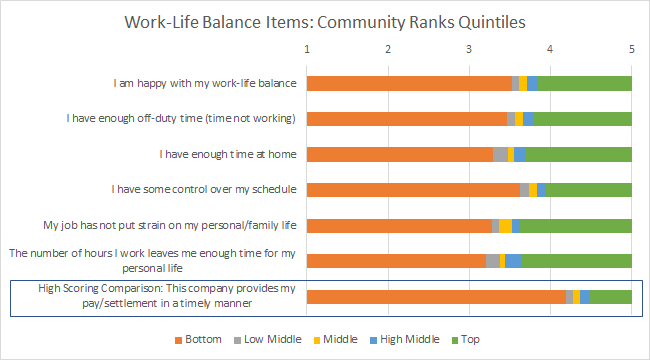One of the key components of many of Stay Metrics’ (acquired by Tenstreet) retention product offerings is the ability to see how you are doing compared to aggregated client data from our database, on a variety of survey questions asked of drivers. These “Community Ranks” are broken down into quintiles that divide carriers into five approximately equal groups based on the scores (1 being the lowest score and 5 being highest) they receive from drivers on individual survey items and groups of items. This proves deeply valuable as our clients can see their areas of strength and opportunities for improvement.

This represents ratings for 26 carriers based on data from over 4,000 surveys received between 6/1/19 and 5/31/20. To be included in the community, each carrier must have at least 20 drivers with valid data for the item/score being analyzed. Some clients were not included as they had not yet transitioned to our new surveys.
One area we study is drivers’ responses to questions focused on work-life balance. The top six items shown above are all a part of the Work-Life Balance section of the existing Stay Metrics Ongoing Survey tool. The last question, regarding pay/settlement, is included as a reference point for a question that has higher ratings. You can see, by comparison, that Work-Life Balance is an area in need of improvement as the chart indicates low scores for the bottom quintiles.
Jerry Scott serves as COO of Stay Metrics and relies on his deep trucking industry experience to help him understand our clients’ challenges. Here are 3 tips from Jerry for addressing work-life balance issues for drivers.
Jerry’s Take
1: Make Home Time a Core Competency!
Family matters most to almost all of us and your systems and policies should recognize the importance of home time. Establish a process to set clear, written expectations at onboarding on how home time works, how often the driver should get home, when, for how long and how to request home time consideration for special events. Have a system to measure how often special home time requests are honored and review your performance regularly. Make certain drivers are never “penalized” for taking home time in accordance with mutually agreed expectations and create a safe process for a driver to report when they feel that home time expectations were not met.
2: Support the Whole Driver!
We all know, but our systems sometimes seem to forget, that the driver is not a component of the power unit. Drivers are living, breathing human beings. Establish a cultural imperative in your company that holistically addresses driver needs including healthy nutrition, exercise, good quality sleep, creature comforts and entertainment. Create a team to address these issues from the point of view of what would each of us need to survive and thrive doing this job day in and day out and get plenty of feedback from drivers. This effort can range from well-being programs, contests, encouragement, tractor specifications that favor sustainability/driver comfort and resources made available to help drivers like coaching, counseling, small business management resources and training.
3: Show Some R-E-S-P-E-C-T!
Aretha Franklin had it right! “All I’m askin’ is for a little respect…” Driver centric cultures are created with intention and they pay significant dividends in loyalty, retention and recruiting word of mouth. Everything matters, from how driver managers/dispatchers are trained and managed to how drivers feel in your facility and how they are communicated with on the road. Open your building to drivers. Make sure their facilities like bathrooms and lounge areas are as nice or nicer than those for office employees. Give drivers ample feedback opportunities to share how they are treated, spoken to and listened to. Make it easy for drivers to reach someone when they need help with some back up process for true emergencies like break downs. Finally, evaluate your office team to see how it compares with your driver team in terms of diversity and inclusion and create opportunities for drivers to transition to the office if they have the desire and ability.
What strategies have worked for you for addressing truck driver work-life balance? We’d love to hear!
Are you interested in seeing how we can help you realize retention? Request a demo to schedule an initial conversation with a member of our team.



